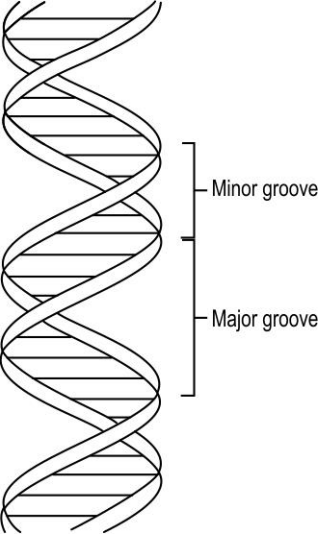The image below shows the double helix structure of a DNA.

(i) The double helix structure is easily destroyed by change in (a) temperature and (b) pH value. Explain the reason for both the cases.
(ii) Suppose the bonds holding the DNA strands for double helix together were (a) covalent bonds (b) London dispersion force. What would be the problem in each case?
Step by step video & image solution for The image below shows the double helix structure of a DNA. (i) The double helix structure is easily destroyed by change in (a) temperature and (b) pH value. Explain the reason for both the cases. (ii) Suppose the bonds holding the DNA strands for double helix together were (a) covalent bonds (b) London dispersion force. What would be the problem in each case? by Chemistry experts to help you in doubts & scoring excellent marks in Class 12 exams.
Updated on:21/07/2023Topper's Solved these Questions
Similar Questions
Knowledge Check
In double strand helix structure of DNA, heterocyclic base cytosine forms hydrogen bond with
AadenineBguanineCpurineDthyamineIn double helix structure of DNA hydrogen bonding present between bases. The correct base pair is
Aadanine-uracilBadanine-cytocineCadanine-guanineDadanine-thymineAssertion: The two strands in double strand helix structure of DNA are complementary to each other
Reason: Disulphide bonds are formed between SQPecific pairs of basesABoth assertion and reason are correct statements, and reason is the correct explanation of the assertionBBoth assertion and reason are correct statements, but reason is not the correct explanation of the assertionCAssertion is correct, but reason is wrong statement.DAssertion is wrong, but reason is correct statement.
Formation OF Phosphodiester Bonds || Nucleic Acids (DNA & RNA ) || Double Helix Structure OF DNA
View Solution(a) What is denaturation of proteins?
(b) What type of bonds hold a DNA double helix together?
(c) Which enzyme is present in saliva? What is its function?
View SolutionWhich of the following bonds are present in a DNA double helix ?
a. Hydrogen bond
b. Peptide bond
c. Glycosidic bond
d. Phosphodiester bond
View SolutionAssertion (A) : The two strands in double strand helix structure ofo DNA are complementary to each other
Reaso (R ) : Disulphide bonds are formed between specific pairs of bases.
View SolutionWhich statement/s is/are incorrect regarding DNA ?
I. DNA has a double helix structure.
II. DNA can be double-stranded or single-stranded in animals
III. The two chains have parallel polarity.
IV. The pitch of the helix is 3.4 nm.
View Solution
